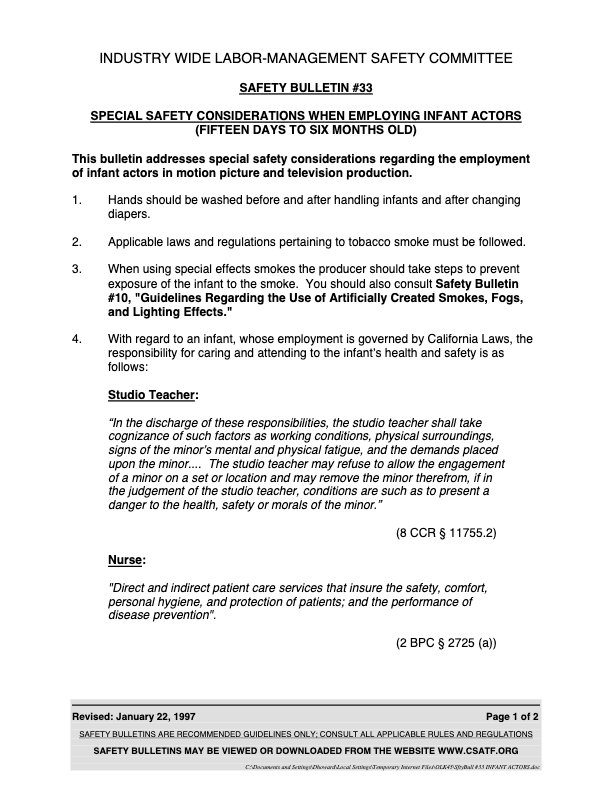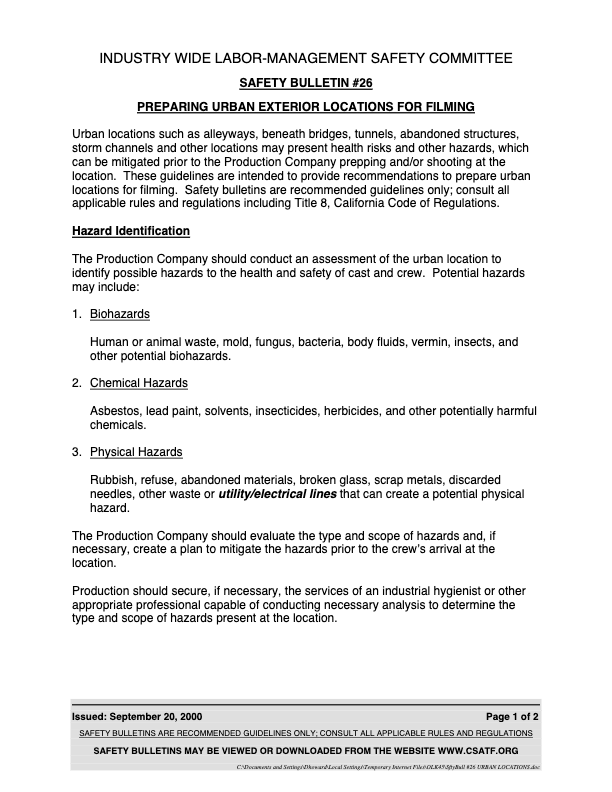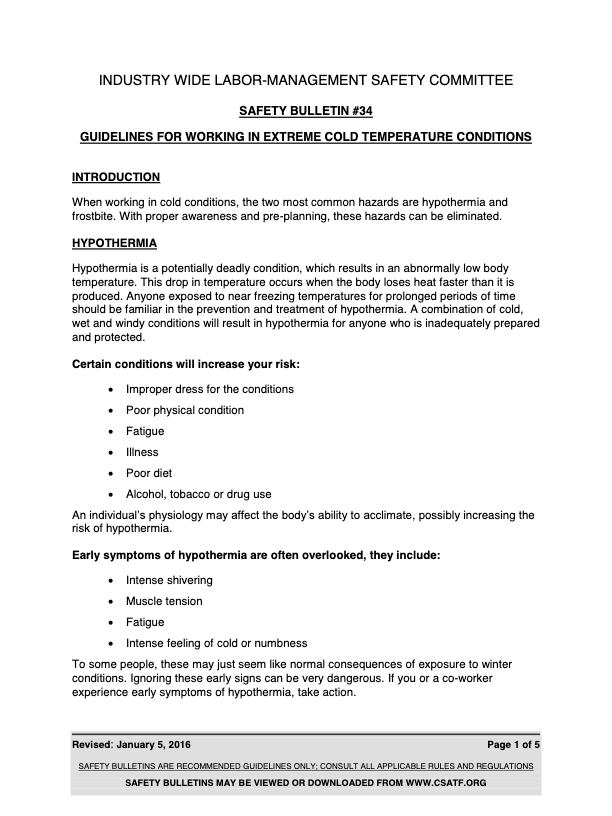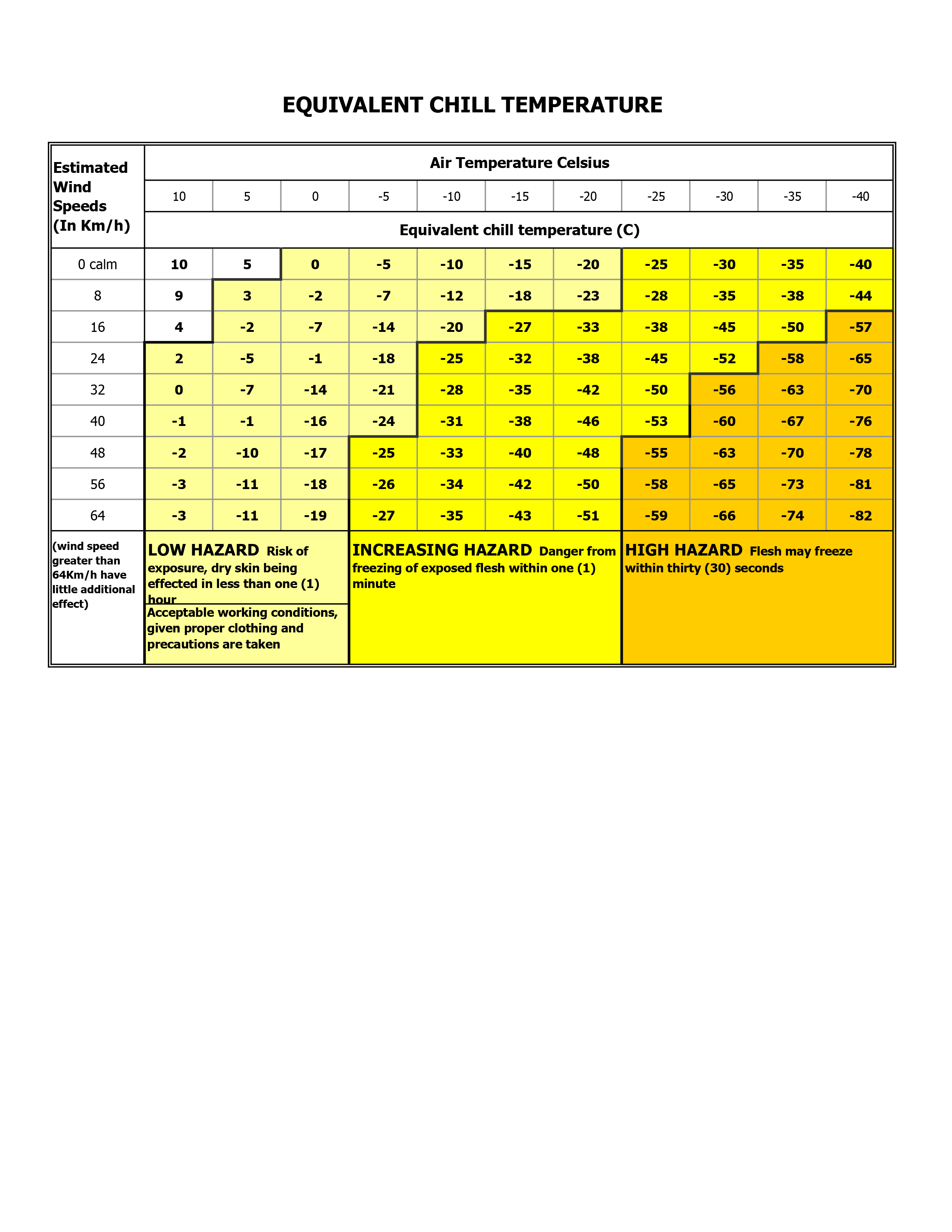Extreme Cold Temperatures
When working in cold conditions, the two most common hazards are hypothermia and frostbite. With proper awareness and pre-planning, these hazards can be eliminated.
Hypothermia
Hypothermia is a potentially deadly condition, which results in an abnormally low body temperature. A combination of cold, wet and windy conditions will result in hypothermia for anyone who is inadequately prepared and protected.
Early symptoms of hypothermia are often overlooked, they include:
- Intense shivering
- Muscle tension
- Fatigue
- Intense feeling of cold or numbness
To most people, these may just seem like normal consequences of exposure to winter conditions. Ignoring these early signs can be very dangerous. If you or a co-worker experience early symptoms of hypothermia, take action.
Also watch for additional behavioral signs including:
- Slurred speech
- Difficulty performing tasks
- Loss of coordination
- Lethargy
- Erratic behavior, poor decisions
- Irritability
- Slow breathing and heart rate
At the first sign of any of these conditions, notify your supervisor and/or seek medical attention (i.e., set medic, studio hospital or medical provider) then go inside and get warm, before you attempt to complete the job or project you are working on.
Hypothermia Prevention
Preventing hypothermia is not difficult. In fact, it is much easier to avoid hypothermia than to treat it after the fact. You can prevent hypothermia if you pre-plan, know what the conditions are expected to be and plan your clothing accordingly.
Clothing:
- Clothing does not warm you; it provides insulation to preserve your warmth. Layer your clothing
- As much as half of your body heat is lost through your head and neck, so keep them covered
- Keep rain and wind out of your clothing
- Avoid overheating and sweating by ventilating as needed
- Wool clothing is best followed by synthetics, down is okay if kept dry, but cotton is a bad choice
Food and behavior:
- Watch what you eat. Minor changes to your normal behavior are an important step in preventing hypothermia
- This is not the time for a starvation diet. It is important to maintain your optimal metabolism
- Take extra steps to stay warm and dry by preventing exposure to wind and water
If you are working in cold weather:
- Do not diet; give your body the appropriate nutrients
- This will increase your metabolism and help keep you warm
- Continue to drink fluids, water is best. No alcohol.
- If you do not need to be outside, go inside, even if it is only for a few minutes
- If you cannot go inside, exercise, jog in place, shake your arms, these activities will increase your circulation and increase heat
If someone is showing signs of hypothermia:
- Hypothermia symptoms should receive medical treatment as soon as possible
- Prevent further heat loss by sheltering from exposure to wind and water
- Bring the crew member inside to a warm area, if possible
- Treat the crew member gently
- Seek medical attention (*i.e., *set medic, studio hospital or medical provider)
- Remove any wet clothing and replace with dry clothing
- Wrap the crew member in blankets and cover their head
- No caffeine, alcohol or tobacco should be used
Frostbite
Frostbite is more common than hypothermia. It is the result of the freezing of the extracellular fluid in the skin, which can permanently damage the tissue. This condition usually affects the extremities, such as the tips of fingers, the ears and nose but other exposed areas can also be affected. Like hypothermia, a combination of elements usually leads to frostbite not cold air alone. In fact, most frostbite is the result of conduction, the rapid transfer of heat, for example, touching cold metal surfaces with bare hands. Exposure to cold temperatures and wind can quickly result in frostbite.
Signs and Symptoms of Frostbite:
- Mild frostbite affects the outer skin layers and appears as a blanching or whitening of the skin. This usually disappears as warming occurs, but the skin may appear red for several hours
- In severe cases the skin will appear waxy-looking with a white, gray-yellow or gray-blue color. The affected parts will have no feeling and blisters may be present. The tissue will feel frozen or “wooden”
- Other indicators are; swelling, itching, burning and deep pain as the area is warmed
Frostbite Prevention
Just as with hypothermia, frostbite is much easier to prevent than it is to treat. All of the items listed above for hypothermia would also apply for frostbite.
- Wear proper clothing which insulates from the cold and provides protection from wind, rain and snow
- Cover your neck and head
- Protect your hands and feet (mittens are warmer than gloves but may limit activity)
- Keep clothing and shoes loose, to ensure good circulation
- Drink plenty of fluids
- Do not diet; give your body the appropriate nutrients
- Alcohol, tobacco or drugs should not be used
- Keep moving, do not stand still
- Take breaks to go inside and warm up
- Never touch a cold metal object with your bare hands
Frostbite Treatment
If you think you may have frostbite, even a mild case, immediately seek medical attention. The following list will provide some guidelines for treating frostbite:
- Get to a place where you can stay warm after thawing; do not allow the affected body area to refreeze
- Seek medical attention (*i.e., *set medic, studio hospital or medical provider), re- warming should be conducted under medical supervision
- Warm water is best for re-warming; do not rub or massage the area, or use dry heat (sunlamp, radiator, heating pad)
- If blisters are present, leave them intact
- No alcohol, tobacco or drugs should not be used
General Precautions
The following are some additional steps the production can take to minimize the risks:
- Monitor local weather forecast information daily and conduct cold stress assessments for all areas
- Provide adequate heated shelters for cast and crew
- Maintain a suitable thermometer and anemometer (wind measuring device) at the site; these will be used to determine the equivalent chill temperature
- Charts for establishing acceptable working conditions based on temperature and wind speed, are attached
- Establish safe areas and paths, no wandering or sightseeing, this will reduce the risk of getting lost










